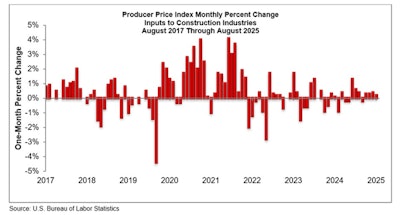The road to recovery – at work
Safety+Health Magazine • September 28, 2025
How employers can support employees who are dealing with substance use disorders
The number of people who worked full time while in recovery from a substance use disorder jumped 44% in 2020 – to 468,000 from 326,000 the year before. Add to that 274,000 workers who are part-time.
Those are the findings of a recent study from the Substance Abuse and Mental Health Services Administration. To Greg Sizemore, vice president of health, safety, environment and workforce development at Associated Builders and Contractors, they come as no surprise.
“We all must commit to creating the conditions for those struggling with substance abuse to come forward and ask for help,” Sizemore said.
As a licensed chaplain, he’s seen what happens when an overdose results in death.
“That ripple effect impacts everybody around the person,” he said. “I have seen the confusion and guilt carried by those close to the person or occurrence. Whether it happens on a construction site or at home, we cannot ignore this issue.”
Sizemore is among a growing number of advocates for recovery-friendly workplaces – also known as recovery-ready workplaces or workplace-supported recovery. Other advocates include federal agencies, states, nonprofit organizations such as the National Safety Council, labor unions, industry associations and individual employers.
The goal of a recovery-friendly workplace is to create a supportive environment for employees recovering from mental health and/or substance use challenges.
The workplace is a ‘critical setting’
“It’s clear that the workplace is a critical setting to address substance use challenges,” said Jamie Osborne, a public health analyst. “It really makes sense given how much of our time we spend at work.”
The Department of Labor says recovery-friendly workplaces adopt policies and practices that:
Expand employment opportunities for people in or seeking recovery.
Facilitate help-seeking among employees with a substance use disorder.
Ensure access to needed services, including treatment, recovery support and mutual aid.
Inform employees in recovery that they may have the right to reasonable accommodations and other protections that can help them keep their job.
Reduce the risk of substance misuse and a substance use disorder, including through education and steps to prevent injury in the workplace.
Educate all levels of the organization on substance use disorder and recovery, working to reduce stigma and misunderstanding, including by facilitating open discussion on the topic.
Ensure prospective and current employees understand that the employer is recovery-ready and familiar with relevant policies and resources.
“How I think of it is bringing substance-use issues out of the shadows,” said Samantha Lewandowski, senior director of the New Hampshire Recovery Friendly Workplace Initiative.
If a workplace is recovery-friendly, that worker can proactively come forward and start the process of getting into a recovery program.
“If that culture isn’t in place, you make it so that person can’t come forward,” she said. “Ultimately, that’s more dangerous.”
Where to start
To Sizemore, safety professionals who want to play a role in their organization becoming a recovery-friendly workplace must have one specific trait: tenacity.
“You can’t quit just because it’s hard,” he said. “In the world of safety, we think about the things that are the lagging indications. We’re asked to investigate why it occurred. We have to go at this with that same tenacity.”
Whether an organization chooses to follow any number of available resources, the decision is a positive one, said Claire Bryant, senior program manager of workplace safety programs at NSC.
“There’s no wrong step here,” said Bryant, who encourages “having the conversation and doing anything you can do.”
That can include providing accommodations for workers to attend recovery programs; conducting anti-stigma education or toolbox talks; having peer advocates onsite; conducting supervisor training; and developing and implementing written, nonpunitive policies.
“Anybody can be part of the movement,” Lewandowski said. “There are a lot of ways we can meet businesses where they’re at. We’re connectors to peers and resources.”
Helpful resources
New Hampshire offers help connecting organizations and people via its document that features scannable QR codes.
“It’s important to remember that programs are not all-or-nothing, one-size-fits-all, cookie-cutter approaches,” Osborne said. “Some policies and practices will be more feasible or more appropriate than others for different employers and workplaces, and that’s OK. Small changes can really have big impact.”
Osborne added that employers can adopt policies one or two at a time and evaluate their impact, choosing a gradual implementation.
The 2022 White House National Drug Control Strategy included supporting recovery as a key component of a long-term response to the issue. That led to the development of a federal Recovery-Ready Workplace Toolkit.
Last year, NSC launched its Workplace Wellbeing Hub, an expansion of its tools and resources aimed at combating overdoses in the workplace.
ABC’s Total Human Health initiative offers more free resources for employers.
In 2018, New Hampshire became the first state to launch a recovery-friendly workplace initiative. Since then, more than 25 states have followed suit.
“It’s really a collaborative movement, and we welcome anybody who wants to play a role in that,” Lewandowski said. “It’s a win-win for the employers and the employees. It helps with not only attracting talent and expanding your labor pool, but also with retaining that talent.”
Barriers and benefits
Despite the advancement of recovery-friendly efforts, a major challenge persists: the stigma surrounding substance-use challenges.
“Employers may express hesitation toward hiring people who are in recovery,” Osborne said, “but there really is evidence to combat these misunderstandings.”
A 2024 NSC survey of 500 employers and 800 workers shows that 70% of the employers and 60% of the workers believe substance use is a justifiable reason to fire an employee.
Half of the surveyed employers and 41% of the workers said substance use is a personal, moral or ethical failure.
“We definitely still have work to do,” Osborne said. “Substance use disorder is a health condition. It’s not a mark of poor character. And it’s not a form of deliberate misbehavior.”
Despite their other opinions, 86% of the employers in the NSC survey, as well as 80% of the workers, said organizations should support employees dealing with substance use. In addition, 54% of the respondents said the safety team should be involved in decision-making about stocking naloxone – an opioid-overdose reversal medication – in workplaces.
NSC makes a business case for recovery-friendly workplaces. According to a recent analysis by the nonprofit organization, an employer, on average, saves $8,500 for each worker who recovers from a substance use disorder.
Even so, overcoming biases often takes a personal approach.
“The more storytelling we can do, the more real this becomes in a workplace,” Bryant said. “It helps make the issue feel real to help employers understand that their employees are just people.”
For Sizemore, he leans on his personal experiences.
“The biggest benefit is just helping another human out,” he said. “I’ve had friends in my lifetime who struggled with addiction. I’ve lost friends over addiction. It doesn’t mean that we don’t try.”








